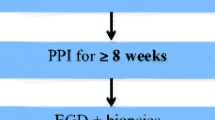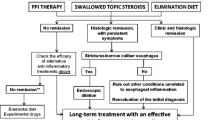Opinion statement
Eosinophilic esophagitis (EE) is an increasingly recognized disease of the esophagus with distinct clinicopathologic features. Adult and pediatric patients experience upper intestinal symptoms including food impaction, vomiting, abdominal pain, or dysphagia. Histopathologic analysis of the distal and proximal esophageal mucosa demonstrates dense eosinophilic infiltration despite proton pump inhibition. Few studies document the long-term outcomes of EE but current evidence suggests that EE is a chronic condition that can sometimes lead to esophageal strictures. Although the incidence of this complication is not yet known, it has sparked significant interest in defining safe, effective treatments. Once a diagnosis of EE is made, patients should seek the consultation of the allergist in an effort to identify possible food sensitivities. This is particularly important because the etiologic agent(s) that drive the eosinophilia are likely different for each patient. If the allergic evaluation identifies a specific food, this food should be strictly avoided as a first-line treatment. If a food is not identified, an elemental formula should be used to induce a remission. If an elemental diet cannot be used, topical steroids are effective in inducing a remission. The side effects associated with long-term steroid administration limit their use as a maintenance medication. Given the lack of prognostic data, the use of systemic corticosteroids should be reserved for severe cases when dietary elimination or topical steroids are ineffective. Most importantly, patients should remain under the care of a physician so that long-term outcomes can be identified. To date, diet restriction has been identified as the only effective maintenance treatment, but montelukast and topical cromolyn may also offer benefit. Anti-interleukin-5 antibody represents an emerging form of targeted therapy.
Similar content being viewed by others
References and Recommended Reading
Ruchelli E, Wenner W, Voytek T, et al.: Severity of esophageal eosinophilia predicts response to conventional gastroesophageal reflux therapy. Pediatr Develop Pathol 1999, 2: 15–18.
Walsh SV, Antonioli DA, Goldman H, et al.: Allergic esophagitis in children: a clinicopathological entity. Am J Surg Path 1999, 23: 390–396.
Orenstein SR, Shalaby TM, DiLorenzo C, et al.: The spectrum of pediatric eosinophilic esophagitis beyond infancy: A clinical series of 30 children. Am J Gastroenterol 2000, 95: 1422–1430.
Straumann A, Spichtin HP, Grize L, et al.: Natural history of primary eosinophilic esophagitis: a followup of 30 adult patients for up to 11.5 years. Gastroenterology 2003, 125: 1660–1669. Documents the longest follow-up of adults with EE.
Potter JW, Saeian K, Staff D, et al.: Eosinophilic esophagitis in adults: an emerging problem with unique esophageal features. Gastrointest Endosc 2004, 59: 355–361.
Croese J, Fairley SK, Masson JW, et al.: Clinical and endoscopic features of eosinophilic esophagitis in adults. Gastrointest Endosc 2003, 58: 516–522.
Kelly KJ, Lazenby AJ, Rowe PC, et al.: Eosinophilic esophagitis attributed to gastroesophageal reflux: improvement with an amino acid-based formula. Gastoenterology 1995, 109: 1503–1512.
Cheung KM, Oliver MR, Cameron DJ, et al.: Esophageal eosinophilia in children with dysphagia. J Pediatr Gastroenterol Nutr 2003, 37: 498–503.
Liacouras CA: Eosinophilic esophagitis in children and adults. J Pediatr Gastroenterol Nutr 2003, 37(Suppl 1):S23-S28.
Desai T, Stecevic V, Chang C, et al.: Association of eosinophilic inflammation with esophageal food impaction in adults. Gastrointest Endosc 2005, 61: 795–801.
Ahmed A, Matsui S, Soetikno R: A novel endoscopic appearance of idiopathic eosinophilic esophagitis. Endoscopy 2000, 32: S33.
Langdon DE: "Congenital" esophageal stenosis, corrugated ringed esophagus, and eosinophilic esophagitis. Am J Gastroenterol 2000, 95: 2123–2124.
Lim JR, Gupta SK, Croffie JM, et al.: White specks in the esophageal mucosa: An endoscopic manifestation of non-reflux eosinophilic esophagitis in children. Gastrointest Endosc 2004, 59: 835–838.
Siafakas C, Ryan C, Brown M, Miller T: Multiple esophageal rings: An association with eosinophilic esophagitis. Case report and review of the literature. Am J Gastroenterol 2000, 95: 1572–1575.
Sundaram S, Sunku B, Nelson SP, et al.: Adherent white plaques: an endoscopic finding in eosinophilic esophagitis. J Pediatr Gastroenterol Nutr 2004, 38: 208–212.
Patel SM, Falchuk KR: Three brothers with dysphagia caused by eosinophilic esophagitis. Gastrointest Endosc 2005, 61: 165–167.
Noel RJ, Putnam PE, Rothenberg ME: Eosinophilic esophagitis. N Engl J Med 2004, 351: 940–941.
Borda F, Jimenez FJ, Martinez Penuela JM, et al.: Eosinophilic esophagitis: an underdiagnosed entity?. Rev Esp Enferm Dig 1996, 88: 701–704.
Straumann A, Spichtin HP, Bernoulli R, et al.: Idiopathic eosinophilic esophagitis: a frequently overlooked disease with typical clinical aspects and discrete endoscopic findings. Schweiz Med Wochenschr 1994, 124: 1419–1429.
Fujiwara H, Morita A, Kobayashi H, et al.: Infiltrating eosinophils and eotaxin: their association with idiopathic eosinophilic esophagitis. Ann Allergy Asthma Immunol 2002, 89: 429–432.
Rothenberg ME: Eosinophilic gastrointestinal disorders (EGID). J Allergy Clin Immunol 2004, 113: 11–28.
Mishra A, Hogan SP, Brandt EB, Rothenberg ME: IL-5 promotes eosinophil trafficking to the esophagus. J Immunol 2002, 168: 2464–2469.
Mishra A, Rothenberg ME: Intratracheal IL-13 induces eosinophilic esophagitis by an IL-5, eotaxin-1, and STAT6-dependent mechanism. Gastroenterology 2003, 125: 1419–1427.
Straumann A, Bauer M, Fischer B, et al.: Idiopathic eosinophilic esophagitis is associated with a T(H)2-type allergic inflammatory response. J Allergy Clin Immunol 2001, 108: 954–961.
Schmid-Grendelmeier P, Altznauer F, Fischer B, et al.: Eosinophils express functional IL-13 in eosinophilic inflammatory diseases. J Immunol 2002, 169: 1021–1027.
Markowitz JE, Spergel JM, Ruchelli E, Liacouras CA: Elemental diet is an effective treatment for eosinophilic esophagitis in children and adolescents. Am J Gastroenterol 2003, 98: 777–782.
Spergel JM, Beausoleil JL, Mascarenhas M, Liacouras CA: The use of skin prick tests and patch tests to identify causative foods in eosinophilic esophagitis. J Allergy Clin Immunol 2002, 109: 363–368. Documents the utility of skin patch testing and dietary treatment.
Fogg MI, Ruchelli E, Spergel JM: Pollen and eosinophilic esophagitis. J Allergy Clin Immunol 2003, 112: 796–797.
Mishra A, Hogan SP, Brandt EB, Rothenberg ME: An etiological role for aeroallergens and eosinophils in experimental esophagitis. J Clin Invest 2001, 107: 83–90.
Liacouras CA, Wenner WJ, Brown K, Ruchelli E: Primary eosinophilic esophagitis in children: successful treatment with oral corticosteroids. J Pediatr Gastroenterol and Nutr 1998, 26: 380–385.
Faubion W, Perrault J, Burgart L, et al.: Treatment of eosinophilic esophagitis with inhaled corticosteroids. J Pediatr Gastroenterol Nutr 1998, 27: 90–93. First description of novel use of topical steroids.
Teitelbaum J, Fox V, Nurko S, et al.: Fluticasone propionate treatment of eosinophilic esophagitis. J Pediatr Gastroenterol Nutr 2000, 31: S140.
Noel RJ, Putnam PE, Collins MH, et al.: Clinical and immunopathologic effects of swallowed fluticasone for eosinophilic esophagitis. Clin Gastroenterol Hepatol 2004, 2: 568–575.
Arora AS, Perrault J, Smyrk TC: Topical corticosteroid treatment of dysphagia due to eosinophilic esophagitis in adults. Mayo Clin Proc 2003, 78: 830–835.
Kaplan M, Mutlu EA, Jakate S, et al.: Endoscopy in eosinophilic esophagitis: "feline" esophagus and perforation risk. Clin Gastroenterol Hepatol 2003, 1: 433–437.
Riou PJ, Nicholson AG, Pastorino U: Esophageal rupture in a patient with idiopathic eosinophilic esophagitis. Ann Thorac Surg 1996, 62: 1854–1856.
Vasilopoulos S, Murphy P, Auerbach A, et al.: The smallcaliber esophagus: an unappreciated cause of dysphagia for solids in patients with eosinophilic esophagitis. Gastrointest Endosc 2002, 55: 99–106.
Langdon DE: Fluticasone in eosinophilic corrugated ringed esophagus. Am J Gastroenterol 2001, 96: 926–927.
Untersmayr E, Bakos N, Scholl I, et al.: Anti-ulcer drugs promote IgE formation toward dietary antigens in adult patients. Faseb J 2005, 19: 656–658.
Attwood SE, Lewis CJ, Bronder CS, et al.: Eosinophilic oesophagitis: a novel treatment using Montelukast. Gut 2003, 52: 181–185.
Garrett JK, Jameson SC, Thomson B, et al.: Anti-interleukin-5 (mepolizumab) therapy for hypereosinophilic syndromes. J Allergy Clin Immunol 2004, 113: 115–119. Details use of novel anti-IL5 antibody in a patient with eosinophilic esophagitis.
Author information
Authors and Affiliations
Rights and permissions
About this article
Cite this article
Ngo, P., Furuta, G.T. Treatment of eosinophilic esophagitis in children. Curr Treat Options Gastro 8, 397–403 (2005). https://doi.org/10.1007/s11938-005-0042-8
Issue Date:
DOI: https://doi.org/10.1007/s11938-005-0042-8




